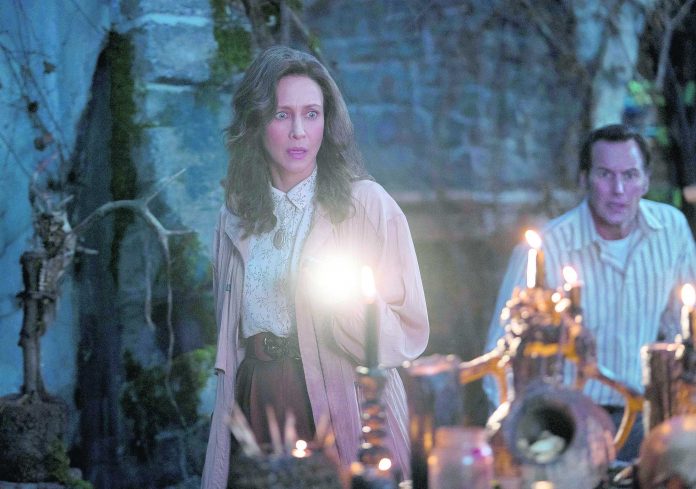
By MARK KENNEDY
AP Entertainment Writer
The universe of “The Conjuring” proves it may be reaching its spooky limits when a demon pops up in the latest film from, of all things, a waterbed.
That such a well-worn punchline of ’80s suburban life could be home to Satan’s spawn might be played for camp in any other movie, but not here.
This gentle franchise is all about timeless scary stuff — swing sets that mysteriously move, battery toys that suddenly turn on and doorknobs that rattle. So the waterbed was perhaps a step too far. What’s next? A demonic Frisbee? A bloody Rubik’s Cube?
It’s a signal that while the franchise soldiers on unironically, the films may fail to keep up with the real world, where the algebra of fear is harder now. Almost 600,000 people in America have died from a murderous airborne plague and Warner Brothers thinks it can terrify those of us who survived — now seated in theaters masked and socially distanced and slightly paranoid — with a moist bed demon?
“The Conjuring: The Devil Made Me Do It” is a fine installment but in an increasingly creaky franchise, appropriate for films that adore the sound of rotting wood floors. It leans into old school horror without really advancing the conceit or upping the scare factor. Its rules are increasingly easy to predict.
Patrick Wilson and Vera Farmiga are back as Ed and Lorraine Warren, a pair of married, devoutly Roman Catholic paranormal pros. The last film drew them “into one of their most diabolical cases.” The new one leads to “the most sinister discovery of their career.” (Here’s betting the fourth will be called the most “pernicious” or “baleful.”)
Based on a real-life murder trial, the movie opens with an exorcism of an 8-year-old in southern New England in 1981 that catapults the demon inside the child into the body of a family friend, Arne Johnson, who then later kills his landlord. Charged with murder, Johnson claims demonic possession, one of the first known cases in which that defense is used.
David Leslie Johnson-McGoldrick’s screenplay — he also co-wrote “The Conjuring 2” — uses that real history and then opens it up to a wider mystery, which may include a missing teenager in another state. The Warrens must find out who is behind it and stop them. “A master Satanist is not an adversary taken lightly,” they are warned.
Director Michael Chaves has real skill with eeriness but we can also see the patterns: Quiet scenes start ordinarily until an odd occurrence happens — say, a cereal box shakes — then the music gets ominous and the camera gets shaky before the split-second shocking addition of a disturbing figure.
Fans of the franchise get some nice call-backs to Elvis and the demonic doll Anabel, while newcomers and veterans alike may never be able to listen to Blondie’s “Call Me” the same way again.
The “Conjuring” universe, kicked off by creator James Wan, now includes three “Conjuring” films and such movies as “Annabelle” and “Annabelle: Creation,” “The Nun” and “Annabelle Comes Home.”
The latest film perhaps belongs in the Warrens’ basement trophy room with all the others, sealed off from the present day like a dusty museum of artifacts. It’s a place to retreat to when you’re looking for what can only be described as comfort terror — lots of flashlights, rats and bones cracking.
But look carefully during the end credits and you’ll see an uncomfortable reminder of our present-day fears: There were three COVID-19 compliance officers on the set. That reminds us of something scary enough to wet the bed for real.



















